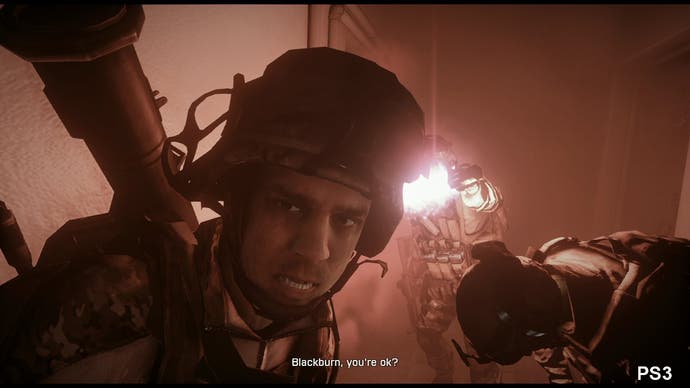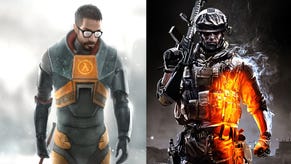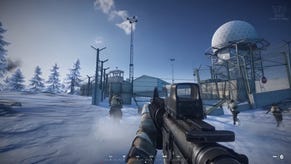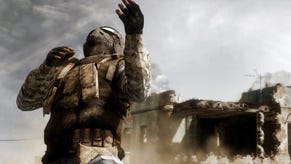Face-Off: Battlefield 3
Why DICE's latest is a "technical masterpiece" on all formats.
Both Xbox 360 and PlayStation 3 versions of Battlefield 3 use a tile-based deferred shading set-up - and it's one of the defining characteristics of the look of the game in both single-player and multiplayer modes. DICE is able to implement a vast range of lighting effects, which interact together beautifully, resulting in some breathtaking scenes. For the vast majority of the game, the two versions basically look identical, with just one exception - found relatively early on in the single-player campaign. Flashlights beamed into the player's face have some tremendous banding issues on the Xbox 360, giving a noticeably pixelised look that is absent on both the PC and PlayStation 3 versions of the game.
It's a curious effect that we don't have a definitive explanation for: it may be a bug (though we'd be amazed it would pass QA if it were) but perhaps more likely, DICE is using an FP10 buffer on the Xbox 360 that doesn't quite have the precision level found in the other versions of the game. It's an intriguing effect that we're seeing here. Bearing in mind that a valid (not to mention quite annoying) multiplayer tactic is to shine a gun-mounted flashlight directly into your opponent's face to dazzle them, it's curious that we've yet to see this artifacting occur outside of this particular cut-scene.


So far then, the final version of Battlefield 3 on console is holding up remarkably well: the technology team at DICE has managed to radically improve upon their existing engine in every regard while providing a level of visual conformity across both console platforms that is even closer than what we saw in the excellent Battlefield: Bad Company 2, but does the new engine have the performance to match?
In previous DICE titles, we've seen the Xbox 360 outperform the PlayStation 3 versions: not to any degree that would impact a purchasing decision, but certainly in a noticeable manner. However, it's clear from the developer's GDC and SIGGRAPH presentations that embracing the many-core architecture of the consoles and mastering the PS3's Cell SPUs in particular has been a priority for the Frostbite 2 tech team and with the new engine we see a much stronger approach in utilising the Sony platform's satellite processors for graphics-intensive work.
So how does all of this work translate into the final product and how can that be tested? The good news is that the Battlefield 3 campaign is an excellent test-bed for seeing just how well the new technology works on console - and the engine-driven cut-scenes, which segue seamlessly with gameplay, allow us to check out how well the game operates in a like-for-like manner on both consoles. These cut-scenes are also notable in that many of them almost seem to be designed to show off some of the new enhancements DICE has made for its new engine - great for testing.
In terms of the basics, the coders have opted to retain the same basic performance profile as previous Frostbite titles. A capped 30 frames per second is the target frame-rate, meaning 33.33ms of rendering time per frame and no screen-tear. However, if it takes longer for the calculations to complete, the framebuffer is flipped during the screen refresh, resulting in screen-tear. Basically, if rendering time increases, the tear moves down the screen. Conversely, if subsequent frames render more quickly, the tear moves back up and v-sync is restored.
The good news is that overall frame-rate is remarkably consistent in these scenes - the only real differentiating factor comes down to the screen-tear, where we see that some scenes operate with an advantage on Xbox 360, while others clearly perform better on the PlayStation 3 - as good a sign as any that DICE has aggressively optimised for the strengths of each platform.
You'll note that much of the tearing takes the form of individual, or small groups of frames at the top of the screen - particularly on the PlayStation3. In these situations it's highly unlikely that you'll actually notice them at all. In other cases, the tearing is much more obvious, and based on our experience with the game, if we had to guess, we'd say that lighting causes more issues for Xbox 360 performance while transparencies are more challenging to the PlayStation 3's RSX.
However, in truth, there are so many rendering technologies in play at virtually any given point that engine load must be immensely variable - it's absolutely remarkable that it's as consistent as it is. For that reason, cueing up like-for-like gameplay isn't so easy: engine stress levels can adjust radically within a split-second, but we should be able to draw some general conclusions from clips snipped from various points within the campaign.
Once again we see no clear winner, though the earlier clips - which are more closely synchronised, do appear to show once again that the PS3 has issues with alpha. Throughout the rest of the segments, we see both versions mostly retaining their frame-rates but with varying levels of screen-tear. The final excerpt, set in one of the more open levels towards the end of the campaign perhaps hints at the larger, more expansive environments causing a few more issues for the console implementation of the Frostbite 2 technology.
Bearing in mind that many of the earlier campaign stages are effectively "corridors" of different shapes and sizes, we were concerned that our analysis may not be representative of the way you'll most likely end up playing the game - in multiplayer, where DICE really goes for it in terms of vast play areas.
However, it's safe to say that the online game has much the same performance profile as the campaign, and if anything the frame-rate is even more stable across the overall run of play. However, divorced from the "corridor" gameplay of the campaign, DICE's streaming technology is really put through its paces. Geometry and texture pop-in is more noticeable, particularly on elements such as foliage, while LOD transitions on environments are significantly more noticeable - though certainly not to anything like the same level as they were in the beta.
Here's a performance analysis of the Xbox 360 version of Battlefield 3 multiplayer, covering off many of the game maps, and we also have a PS3 equivalent to look at too, just one click away. It's noteworthy that some have seen some frame-rate and corresponding input lag concerns with the PS3 game, but in our playtest there was nothing particularly amiss - the experience was pretty much exactly the same as the 360 version.








